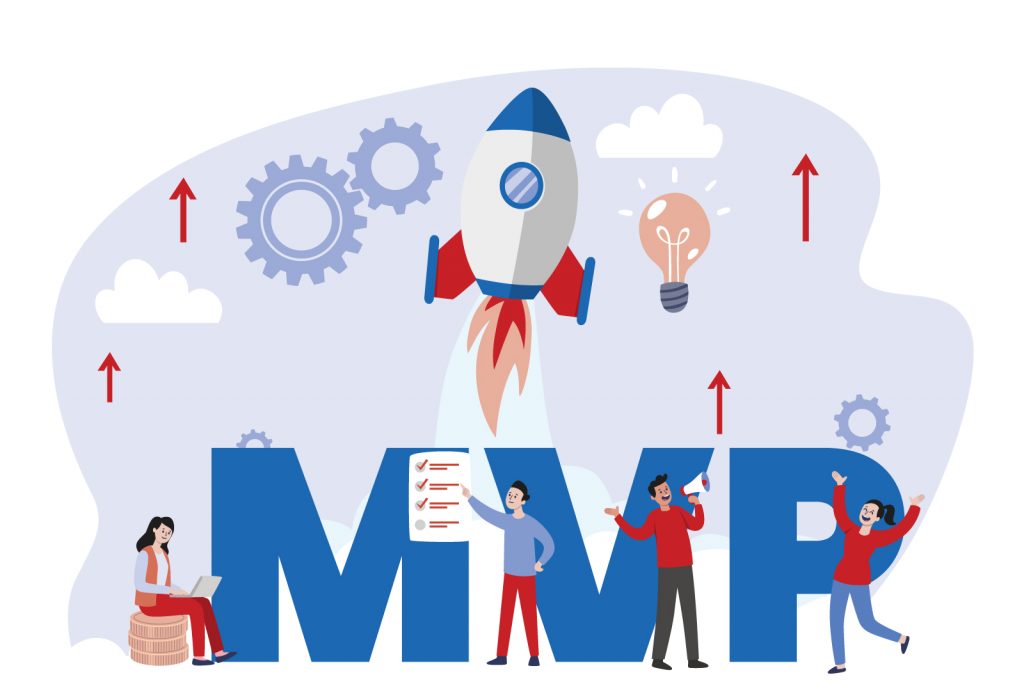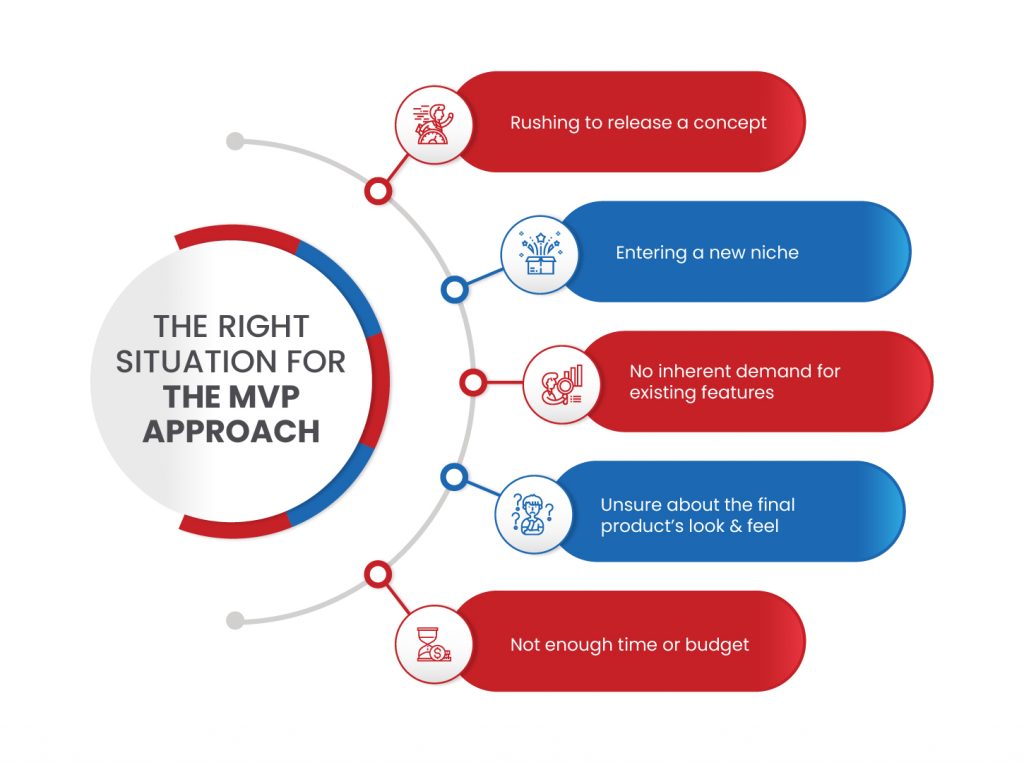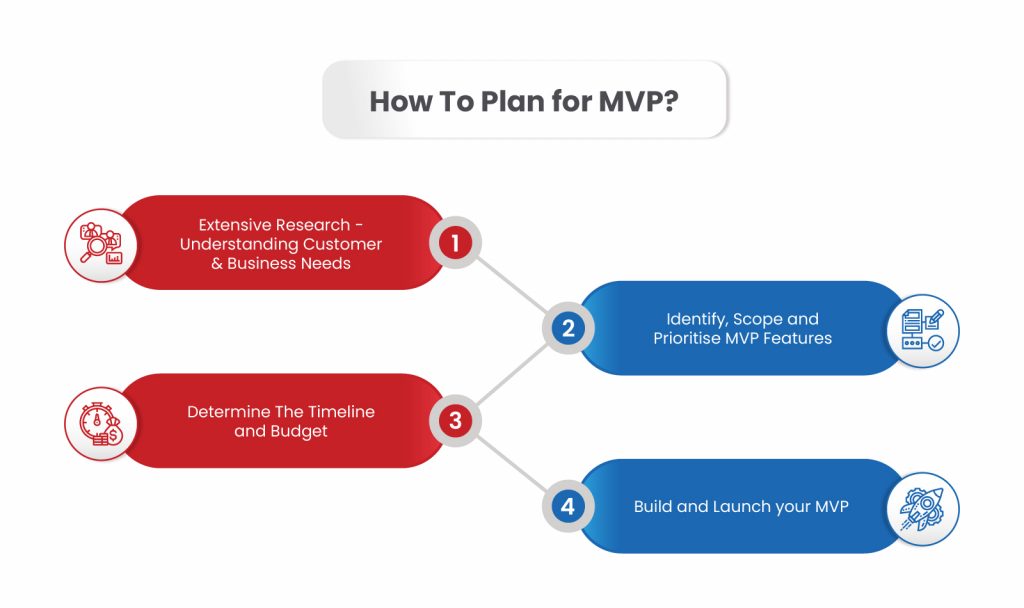
What Is An MVP & Why Is A Roadmap Crucial To Product Success?
Julian Wallis
23 min read

Learn everything you need to know about creating a minimum viable product (MVP), from what it is to why you need one through to the steps involved in creating one.
Creating A Foolproof MVP Roadmap ✍️
Launching a software product is an arduous task. There is so much work that goes behind the scenes, which often gets overlooked during the flush of the excitement surrounding the product launch.
If you’re a business owner, you know that innovation is key to success. You also understand that it’s not always easy to innovate, especially when starting out. That’s where the MVP comes in.
MVP stands for “minimum viable product,” and it’s a strategy for getting a new product or service off the ground quickly and efficiently.
This guide will cover everything you need to know about planning an MVP. We’ll also go through what an MVP is, its benefits, the challenges you should be aware of, and all the steps involved in creating a foolproof MVP roadmap. Let’s get started!
So What Actually Is An MVP? 🤔
If you follow the Agile methodology of software development, you must know what an MVP is because creating a minimum viable product before a full-scale product originates from the best practices of Agile methods.
The Agile Methodology, at its core, is built on the foundation of continual feedback and iterative cycles to improve a product concept. The product concept that starts this all off is the minimum viable product.
In essence, the MVP approach follows a step-by-step product evolution keeping in mind users’ feedback. It also corresponds to the philosophy of ‘ship early, repairs later,’ supported by many notable minds, including Reid Hoffman, the founder of LinkedIn, and Eric Ries, who first introduced the MVP technique in his book “The Lean Startup.”
According to Eric, an MVP is “that version of a new product which allows a team to collect the maximum amount of validated learning about customers with the least effort.”

If we take a closer look at that definition, the use of the words minimum and maximum gives us the basic gist of the MVP concept. The purpose of an MVP is not to provide a robust solution right off the bat but to gather enough feedback from end-users to make better-informed decisions regarding future improvements.
Pursuing product enhancements that will help the user have a better product experience is the ultimate goal following each iterative process.
Why Do Most Startups Never See The Light At The End Of The Tunnel? 💡
A recent study by Investopedia discovered that as of March 2021, only 80% of startups survive their first year in business. But why is that? Sure, financial and technical expertise plays a big hand, but so does choosing the right industry niche and carrying out effective market research for your offering.
Following the step-by-step development process involved in creating an MVP would help such businesses succeed in the long run. Most startups either don’t invest much time gathering market information or neglect it head-on with their assumptions. This is where they go wrong.
As it turns out, they build a product that they think is right for their audience, which is usually not the case.
The MVP process effectively solves this problem because you’ll constantly communicate with your end-users throughout the product development process. So much so that inevitably you’ll create a product that your customer actually wants and needs, leading to more sales and growth for your company.
A product can be called minimally viable if it has some features to be validated within the market and brings the core value for early adopters. Most of the notable products, including Airbnb and Twitter, started their way as MVPs and have been gradually evolving into trendsetting startups.
Beginner entrepreneurs may doubt the necessity and feasibility of this concept and prefer to skip the MVP stage. But that’s a risky decision, and their product may fail.
Startups need MVPs to validate their opportunity hypothesis and get the green light for developing a full-fledged product. In simpler terms, you are essentially asking your end-user if the product would help them solve a problem or not.
Though it’s functionally constrained and raw in appearance, an MVP is meant to deliver the core value and get feedback to move on.
Imagine if companies like Airbnb or Twitter never pursued an MVP process; we most likely wouldn’t have known about their products, let alone seen them turn into international tech powerhouse brands.
Does Your Business Need An MVP? 💭
The concept of MVP was designed to deliver prompt value within the least amount of time and effort. By creating an MVP, you will be guaranteed a product with enough initial capabilities to garner interest and attract early adopters.
These early adopters could be the key to understanding if the product concept has a more significant role to play in your business or not. Say the initial users validate the MVP; then, it would be wise to pursue further enhancements. On the flip side, discarding the project would save plenty of time, effort and resources from being wasted if the reviews are uninspiring.
Now, you might be thinking; if MVPs are so great, I’ll be sure to try it out. Well, hold your horses for a second, there. While an MVP is likely to be the ideal solution to effectively see a product concept from ideation to launch, it might not be the right strategy for everyone.
For starters, with MVPs, we are not necessarily talking about minimal products. Suppose you understand an MVP as releasing a “minimum” product. In that case, you’ll run the risk of launching a product with limited capabilities much early to market and possibly delivering an overall sub-par user experience.
There’s a crucial difference between a minimal product and a minimum viable product, and yes, that difference is the viability aspect. It has to offer value of some sort by having at least some desirable usable and functional features.
Let’s take an example to understand this more clearly.
If you just want to build something for a quick flip, you don’t need to follow the MVP process because there is no need to get continuous customer feedback and validation. You build it and sell it for more money than it costs to produce.
MVPs should be reserved for product concepts that are fresh, unique and likely to surprise and excite customers. If your customers just want something similar to what you already do, then don’t pursue an MVP.
Furthermore, MVPs are not the right path if your product already has a solid consumer base with clearly defined expectations. Lastly, suppose you are in a competitive market with an established demand for existing features. In that case, it’s probably not worth taking the risk with an iterative process of building an MVP — no point reinventing the wheel when there is no need to do so.
The critical thing to remember here is that whilst MVPs are designed to reduce the overall workload and time to launch a product, it will still require a ton of work. For instance, the development and production teams won’t have as much to do, but your testing and communications teams will have their work cut out.
A lot of upfront planning is also required to get customer feedback in a timely and reliable fashion. Furthermore, in an MVP development process, you’ll launch the same product multiple times, which means more work for your development and marketing teams with each passing iteration.
Why An MVP Might Be Exactly What Your Business Needs 🌟
Now, let’s not be too much of a negative-Nelly. It’s obvious that following an MVP process might not be necessary for everyone. Still, it is perhaps the best method to deliver a highly functional, desirable and usable product for the vast majority.
We’ll now go over some scenarios where following a product development process, including an MVP at the forefront, is the right one.

The MVP approach is right for you if:
- You want to release a product concept to market as soon as feasibly possible,
- You are entering a new product or market niche,
- There is no inherent demand for existing features that your product concept fulfils,
- You are unsure about what the final product will look and feel like, or
- You don’t have time or budget to thoroughly plan and scope the complete version of your product idea.
Benefits Of Following An MVP Approach 🦸♀️
As we’ve already discussed before, building an MVP is all about ensuring immediate value is provided with a functional and usable version of a product in the quickest time possible with the least effort applied. But there are more perks to the MVP approach than just this core benefit.
Generate Awareness 🗣️
By being early to market, your product is exposed to the end-users much earlier than they would normally. This is great for the business from a commercial and brand awareness standpoint.
MVP is a lean version of a product you will release later on. Though it lacks some top-notch features and advanced functionality, it does provide value to users and hence acquires early adopters.
The main goal of such an immature product release is to gather feedback to validate the product value offering. Nevertheless, it does not prevent you from starting to make up a customer base and excite customers with future enhancements based on the feedback received.
Resources Optimisation ⚙️
Your idea might be brilliant in your head, but the market may reject it for various reasons like tough competition, inadequate value proposition, and poor marketing.
As a result, tons of hours appear to be spent on unwanted products, not to speak of the hefty funds wasted. The MVP framework lets you avoid this scenario and try out your hypothesis with the actual user.
By utilising the opportunity to access early adopters, your product will receive immediate feedback, ultimately providing the direction to move ahead.
If the market accepts your barebone product, the chances of success with the fully functional version are higher. If not, you are not losing much as you’ll avoid the risk of wasting time and money and get an opportunity to shift focus or fix the value proposition of your product.
In this way, you are fully optimising your resources and building a product that will appeal to your customers.
Focused on Product Offering 💼
The ultimate answer to the question “Why is the minimum viable product important?” is the utmost emphasis on the value you will deliver with your product.
Your product will immediately offer a unique and valuable solution from the get-go. As the iterative cycles pass, your value offering will grow from strength to strength, collecting insightful and relevant feedback from end-users.
Therefore, the MVP lets you understand different problems your future customers need to solve and create a solution that perfectly addresses them.
Core Functionalities Come First 🥇
The MVP approach to product development enforces clarity and focus on achieving the core fundamental functionalities of a product. It allows you to test out the core concept of a solution with your audience before deciding on the future of said product based on what the customers think.
“Scope-creeping” is something that most product owners face repeatedly. For anyone who is not aware of this term, scope creep is a situation in a project where additional functionalities are added beyond the agreed-upon project scope, resulting in delays and budget overruns.
Adding functionalities beyond the fundamental features of a product is necessary to build a superior product but is not required in the initial phases of the product development cycle. You will not only lose focus on the core value offering of your product but also end up spending unnecessary time, effort and resources at the same time. This will lead to delayed time-to-market, allowing competitors to catch up or overtake you.
Early Access To Customers 👪
Throughout this guide, we’ve mentioned the term “early adopters” several times for a good reason. One of the most significant benefits of building an MVP is that it opens the door for you to build relationships with customers reasonably quickly.
If you ask most business owners what problems they faced in their early years, they will likely say “establishing a loyal and reliable consumer base.” The MVP is the answer to this problem.
Early adopters will provide invaluable information and feedback about the product and create buzz and awareness. You’ll have more customers and a product solely built to solve their problems.
Completely Understand What Your Customers Want 💬
Market research and industry analysis are fundamental parts of developing and launching a successful product. But, you know what is better? Hands-on feedback from early adopters.
Let’s face it; your customers are the ones that will buy your product. So, do you think there is anyone else that will provide more meaningful information about your product than the ones who will be using it? Absolutely not!
Your customers will tell you what they like about your product and what they don’t like, and the features they would like to see in future versions. Feedback such as this is an absolute gold mine and will make future versions of your product more popular and successful.
Clear & Simple User Experience 🥽
Because we are only focusing on the fundamental features of a product, the MVP’s User Interface (UI) will be simple and straight to the point.
The lack of clutter and redundant functionalities will offer a meaningful and convenient user experience. All of this means early adopters will be able to use every aspect of the product to the fullest without being confused by unnecessary complexity.
All of this results in you receiving product feedback that is specific, powerful and valuable.
Minimal Risks, Maximum Rewards 🏆
The largest software products globally, such as Facebook, Instagram, YouTube and more, started as MVPs. The core functionality and value offering were transparent for everyone to see, but they didn’t have anywhere near the level of features and capabilities that they do now.
Through multiple cycles of launching new features that complemented the core value offering, they were able to create software products used by a majority of the planet.
The concept is simple, you start small and add to it from there, instead of going all-out from the start and risking it all on the line.
In essence, you’ll find that the MVP approach is relatively risk-free because development and design costs are vastly reduced. After all, you won’t have to worry about creating secondary features that could prove unnecessary. You can never predict how customers will react, so it’s best to stay safe and avoid putting all your eggs in the same basket.
Challenges While Implementing an MVP Approach ✋
Yes, the benefits of creating MVPs in your product development process can be potentially game-changing for your business.
However, it is also essential to understand what can go wrong and what you need to be wary of if you truly want to maximise your gains by following this product development process.
Struggling To Completely Understand Your Customers 👩👩👦
No matter how good your product idea is, you won’t achieve anything with it if it doesn’t help a customer segment. If you want people to download your app, it must offer desirable and valuable features for the intended customer.
But unfortunately, this is where most products fail due to a combination of different factors. These include poor or inadequate market and customer research, limited knowledge of your ideal customer, and too many unnecessary features that muddy your product’s real purpose and offering.
Misaligned Project Management Strategy 📂
How you manage your projects plays a big part in the success of your MVP. There needs to be an exact alignment between how you develop products and how you manage the entire process from conception to release.
The project management methodologies commonly used in software development are Agile and Waterfall. A fundamental difference between these two ideologies relates to an MVP is how your product is released to the market for validation and feedback.
The sequential approach of Waterfall is not suitable for smaller time-sensitive projects like an MVP. Because you have to wait for each step in the process to conclude before progressing, it will take a long while before your product reaches your customers. This opens the door for competitors to interfere and capitalise.
Therefore, the clear winner for developing an MVP is the Agile framework, which tends to be much more flexible, and facilitates frequent consumer interaction, precisely what the MVP approach entails.
With that said, the problem arises if your business is well-acquainted with the Waterfall methodology, and in that case switching to Agile may be a radical change for the company as a whole.
Incompetent Resources 🗄️
Expecting amateurs to develop and create best-in-class products is unrealistic. Many businesses base their choices on costs and expenses when they should be focused solely on the quality of the MVP.
Think about it for a second; you are already launching a barebone version of a product concept, and you don’t want it to be low-quality, too, do you?
Your first swoop into the market should be with a genuinely unique and high-quality product that creates buzz and excitement — and attracts as many early adopters as possible. Think of it as creating a first impression.
How To Plan for MVP? 💭
Now that we have a clear picture of what an MVP is, when it should and shouldn’t be implemented, and some incredible benefits that follow the MVP development process, let’s go through all the steps involved in creating an MVP.

1️⃣ Extensive Research – Understanding Customer & Business Needs 🤗
While the urgency and excitement to define and scope all the features to include the MVP will be tempting, it should never be the first thing you do. A thorough understanding of your market, competitors, customers and business objectives is vital and serves as the bedrock for successfully developing the MVP.
The first step in the MVP development process should be to understand why your business needs the MVP and how developing it will help your company achieve its goals and objectives.
Discussing internally amongst key stakeholders is a great way to start this process. If you conclude that the MVP concept aligns with your business objectives, you’re off to a great start!
Moving forward, you must also be fully aware of what your customers need and how your product concept will help them solve the problems that they are facing.
You need to get an insight into the pain points your customers are facing and possible solutions. You’ll have to answer several questions like:
- What is the market like?
- Who is my ideal customer, and what issues are they facing?
- What is the problem my product solves?
- How does my product benefit the customer?
You have to think about the value your product brings your customers and how they will benefit from your product. Build a value proposition of your product to have all the information you need.
Use a value proposition canvas to visualise how you can position your product to match your customers’ needs. A value proposition canvas is a visual framework designed to create an ideal relationship between the product and the market it enters or is operating in.
Furthermore, you will also get a good idea of your ideal buyer by following the research process. What sort of users will be interested in your product? From our experience, creating buyer personas based purely on your assumptions tends to be very inaccurate as you’ll eventually notice a lack of authentic and specific customer insights.
You should work with internal and external information to create your buyer personas. Interviewing some of your past customers and running a customer survey are great tools to get relevant insights from your audience.
You must understand who will buy your product before launching the MVP to get feedback and reaction. Certain categories of users have specific needs and requirements that can help you improve your product and make it user-friendly.
Finally, you can never forget about your customers. This may not be as important if your product idea is brand new and unlike anything available in your market niche. Still, for the rest, competitor analysis is an integral part of the MVP development process.
- What are the existing solutions to this problem?
- Are there any existing products or services that serve a similar purpose?
- How different is our product from the competition?
- Why should users choose my product over others?
Answering questions such as these should be the aim of your competitor’s research process to identify possible pitfalls and avoid them in your product.
This stage of your MVP development process can be as complicated, extensive, and lengthy as possible. But, it is always better to perform comprehensive research and be adequately prepared to avoid surprises down the road.
2️⃣ Identify Scope and Prioritise MVP Features 💻
The next step deals with the features you want to have implemented in your product. This is where the magic happens!
This step is a make or break for your MVP process because you run the risk of creating an MBP (Most Beautiful Product) if you decide to build all the features that you think are important.
Remember, the goal of an MVP is not to build a product with features that you think need to be included. Instead, the MVP is supposed to be a user-centric product solution composed of just the core features that facilitate solving your user’s pain points. It should be a relatively risk-free and cost-effective way to enter a market to gauge whether or not that market will offer growth and revenue for your business.
So, you must develop a clear product vision and list the features you initially want the product to have. There are a few ways you can go about doing this; here are a few of our favourites:
❄️ The User Journey Can Be Your Compass
An excellent way to visualise the necessary features of an MVP is to outline the user journey of your product.
Here’s an exciting exercise, think about 2 to 3 primary use-cases an end-user must go through to get total value from the product. Next, list all the features and functionalities required to perform said use-cases.
Well, there you have it! The functionalities you list out are your core MVP functionalities that must be included in the first iteration. Anything beyond these features can derail progress, increase costs and incur more risks.
❄️ The MoSCoW Approach
The MoSCoW approach is an excellent method to prioritise and manage product requirements. The acronym comprises four components: Must-have, Should-have, Could-have, and Won’t-have.
At the MVP stage, you’re likely to have one top-priority core feature that conveys the core value offering of the product.
These features would be your “Must-have” features that have to be present in the product for it to be helpful to the end-user. These features should not be compromised and are central to the product’s quality and user experience.
Next, we have the “Should-have” features. These features are essential to the MVP’s functionality, but the quality of implementation can be compromised at this stage and doesn’t need to be fully-fledged. The development of such features is acceptable, and you can work on enhancing them in future releases.
“Could-have” features, on the other hand, are not mandatory but are worth having. Think of them as additional opportunities that you can add to the MVP or future versions. These features are not integral to the product’s core functionality and can be heavily compromised or even neglected in the MVP stage.
Our recommendation would be to estimate the cost and timeline implications of “could-have” features to identify easy wins and low hanging fruits that can be implemented within the MVP. The rest should be reserved for later versions.
Lastly, while scoping and identifying features to include in the MVP is essential, doing the same for items that won’t be is equally, if not more important. This is where the “Won’t-have” features come into the picture.
After drawing a list of features, and user flows, you’ll also likely have a definite list of what you won’t be doing. If not, then it’s most likely that you aren’t prioritising well and have taken on too much in the MVP stage itself because the “cream should rise to the top!”
MVPs require tough decisions, and not having a list of rejected ideas is an alarming sound that may indicate a lack of research and insight into the product’s target market and value proposition. So, it is best to revisit the earlier stage if you struggle to prioritise features in the MVP stage of the product development cycle.
3️⃣ Determine The Timeline and Budget
The next step in the process should be to identify and allocate an appropriate budget and schedule based on the finalised core features that your MVP will include.
The budget is more manageable because you know or should know how much money you have for building the product. But as you hire a team (and time becomes money), things become a lot more complicated.
However, it is important to prioritise a target timeline and work accordingly. Timeline considerations can be around budget available, resources at the disposal, market opportunities, or investor directives.
A common mistake is to only factor in development cost and completely neglect product launch and after-sales support expenses.
4️⃣ Build and Launch your MVP
Finally, put your plan into action and Develop and later launch your MVP based on the research and prioritisation of features done in the previous steps.
By launching the product, you gain early access to the market and get an opportunity to get a sense of reception that your product gets from end-users which allows for appropriate improvements and adjustments in later versions.
Putting It Altogether ✨
All in all, an MVP is the perfect way to test the waters with your product. It allows you to gauge interest from potential customers and make necessary adjustments before investing too much time and money into developing a full-fledged product.
By following this guide, you’ll be one step closer to building a software product that could potentially take your business to the next level.
If you’re ready to start building your MVP, we’re here to help. Our team of experts has extensive experience in helping businesses like yours create products that users love. Book a discovery chat today, and let us show you how we can help turn your idea into a reality.
Topics
Published On
May 23, 2022

